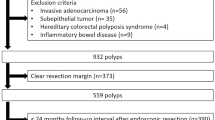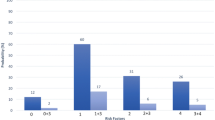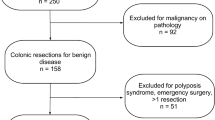Abstract
Background and Aims
Referrals for endoscopic management of large non-pedunculated (NP) colorectal polyps have increased as new techniques have emerged. The outcomes for referred large NP polyps based on the polyp morphology were investigated
Methods
A retrospective review of patients referred for large (≥20 mm) NP polyp management from January 2010 through June 2014 was completed. Polyp morphology was classified as either a NP polyp with depression (M1) or NP polyp with no depression (M0). Differences in treatment, histology, adverse events, outcomes at follow-up including residual disease, and need for surgical treatment were determined by morphology for all NP polyps ≥20 mm in size.
Results
One-hundred and sixty-nine M1 and 136 M0 polyps ≥20 mm were removed endoscopically during the review period. Mean size was 31.9 ± 11.0 mm in M1, and 26.8 ± 9.5 mm in M0 group (p < 0.0001). En bloc resection was possible in 18.3 % of M1 and 30.9 % of M0 lesions (p = 0.011) with endoscopic submucosal dissection used in 13 and 2.2 % of polyps, respectively (p < 0.0001). Residual polyp was found in 26.5 % (27/102) of M1 and 13.6 % (12/88) of M0 patients at surveillance colonoscopy (p = 0.029). On multivariate analysis, piecemeal resection and M1 morphology showed significant association with residual polyp (OR 4.23, 95 % CI 1.23–14.59, p = 0.022, and OR 2.15, 95 % CI 1.004–4.62, p = 0.049, respectively).
Conclusion
Effective endoscopic management of large NP colorectal polyps, especially polyps without depression (M0), can be accomplished in the great majority of patients. Polyp morphology, particularly the presence or absence of depression, is a useful tool which influenced treatment, histology, and outcomes.



Similar content being viewed by others
References
Winower SJ, Zauber AG, Ho MN, et al. Prevention of colorectal cancer by colonoscopic polypectomy. N Engl J Med. 1993;329:1977–1981.
Zauber AG, Winawer SJ, O’Brien MJ, et al. Colonoscopic polypectomy and long-term prevention of colorectal-cancer deaths. N Engl J Med. 2012;366:687–696.
Nishihara R, Wu K, Lochhead P, et al. Long-term colorectal-cancer incidence and mortality after lower endoscopy. N Engl J Med. 2013;369:1095–1105.
Siegel R, Ma J, Zou Z, et al. Cancer statistics, 2014. CA Cancer J Clin. 2014;64:9–29.
Muto T, Bussey HJR, Morson BC. The evolution of cancer of the colon and rectum. Cancer. 1975;36:2251–2270.
Lieberman DA, Rex DK, Winawer SJ, et al. United States Multi-Society task force on colorectal cancer. Guidelines for colonoscopy surveillance after screening and polypectomy: a consensus update by the us multi-society task force on colorectal cancer. Gastroenterology. 2012;143:844–857.
Brenner H, Chang-Claude J, Seiler CM, Hoffmeister M. Long-term risk of colorectal cancer after negative colonoscopy. J Clin Oncol. 2011;29:3761–3767.
Baxter NN, Warren JL, Barrett MJ, et al. Association between colonoscopy and colorectal cancer mortality in a US cohort according to site of cancer and colonoscopic subspecialist. J Clin Oncol. 2012;30:2664–2669.
Rex DK, Ahnen DJ, Baron JA, et al. Serrated lesions of the colorectum: review and recommendations from an expert panel. Am J Gastroenterol. 2012;107:1315–1329.
Rembacken BJ, Fujii T, Cairns A, et al. Flat and depressed colonic neoplasms: a prospective study of 1000 colonoscopies in the UK. Lancet. 2000;355:1211–1214.
Higaki S, Hashimoto S, Harada K, et al. Long-term follow-up of large flat colorectal tumors resected endoscopically. Endoscopy. 2003;35:845–849.
Conio M, Repici A, Demarquay J, et al. EMR of large sessile colorectal polyps. Gastrointest Endosc. 2004;60:234–241.
Kaltenbach T, Friedland S, Maheshwari A, et al. Short- and long-term outcomes of standardized EMR of nonpolypoid (flat and depressed) colorectal lesions ≥1 cm (with video). Gastrointest Endosc. 2007;65:857–865.
Swan MP, Bourke MJ, Alexander S, et al. Large refractory colonic polyps: is it time to change our practice? A prospective study of the clinical and economic impact of a tertiary referral colonic mucosal resection and polypectomy service (with videos). Gastrointest Endosc. 2009;70:1128–1136.
Luigiano C, Consolo P, Scaffidi G, et al. Endoscopic mucosal resection for large and giant sessile and flat colorectal polyps: a single-center experience with long-term follow-up. Endoscopy. 2009;41:829–835.
Ferrara F, Luigiano C, Ghersi S, et al. Efficacy, safety and outcomes of ‘inject and cut’ endoscopic mucosal resection for large sessile and flat colorectal polyps. Digestion. 2010;82:213–220.
Moss A, Bourke MJ, Williams SJ, et al. Endoscopic mucosal resection outcomes and prediction of submucosal cancer from advanced colonic mucosal neoplasia. Gastroenterology. 2011;140:1909–1918.
Buchner AM, Guarner-Argente C, Ginsberg GG. Outcomes of EMR of defiant colorectal lesions directed to an endoscopy referral center. Gastrointest Endosc. 2012;76:255–263.
Singh S, Singh PP, Murad MH, et al. Prevalence, risk factors, and outcomes of interval colorectal cancers. Am J Gastroenterol. 2014;109:1375–1389.
Participants in the Paris Workshop. The Paris endoscopic classification of superficial neoplastic lesions: esophagus, stomach, and colon. Gastrointest Endosc. 2003;58:S3–S43.
Soetikno RM, Gotoda T, Nakanishi Y, et al. Endoscopic mucosal resection. Gastrointest Endosc. 2003;57:567–579.
Kudo S, Lambert R, Allen JI, et al. Nonpolypoid neoplastic lesions of the colorectal mucosa. Gastrointest Endosc. 2008;68:S3–S47.
Tanaka S, Kashida H, Saito Y, et al. JGES guidelines for colorectal endoscopic submucosal dissection/endoscopic mucosal resection. Dig Endosc. 2015;27:417–435.
Woodward TA, Heckman MG, Cleveland P, et al. Predictors of Complete Endoscopic Mucosal Resection of Flat and Depressed Gastrointestinal Neoplasia of the Colon. Am J Gastroenterol. 2012;107:650–654.
Lee SP, Kim JH, Sung IK, et al. Effect of submucosal fibrosis on endoscopic submucosal dissection of colorectal tumors: pathologic review of 173 cases. J Gastroenterol Hepatol. 2015;30:872–878.
Snover DC, Ahnen DJ, Burt RW, Odze RD. Serrated polyps of the colon and rectum and serrated polyposis. In: Bosman FT, Carneiro F, Hruban RH, Theise ND, eds. WHO classification of tumours pathology and genetics. Tumors of the digestive system. 4th ed. Lyon: International Agency for Research on Cancer (IARC) Press; 2010:160–165.
Soetikno RM, Friedland S, Kaltenbach T, Chayama K, Tanaka S. Nonpolypoid (flat and depressed) colorectal neoplasms. Gastroenterology. 2006;130:566–576.
Pohl H, Srivastava A, Bensen SP, et al. Incomplete polyp resection during colonoscopy–results of the complete adenoma resection (CARE) Study. Gastroenterology. 2013;144:74–80.
ASGE TECHNOLOGY COMMITTEE, Kantsevoy SV, Adler DG, Conway JD, et al. Endscopic mucosal resection and endoscopic submucosal dissection. Gastrointest Endosc. 2008;68:11–18.
Burgess NG, Pellise M, Nanda KS, et al. Clinical and endoscopic predictors of cytological dysplasia or cancer in a prospective multicentre study of large sessile serrated adenomas/polyps. Gut. 2016;65:437–446.
Abdeljawad K, Vemulapalli KC, Kahi CJ, Cummings OW, Snover DC, Rex DK. Sessile serrated polyp prevalence determined by a colonoscopist with a high lesion detection rate and an experienced pathologist. Gastrointest Endosc. 2015;81:517–524.
East JE, Vieth M, Rex DK. Serrated lesions in colorectal cancer screening: detection, resection, pathology and surveillance. Gut. 2015;64:991–1000.
Author information
Authors and Affiliations
Corresponding author
Ethics declarations
Conflict of interest
None
Rights and permissions
About this article
Cite this article
Lim, S.H., Levenick, J.M., Mathew, A. et al. Endoscopic Management of Large (≥2 cm) Non-pedunculated Colorectal Polyps: Impact of Polyp Morphology on Outcomes. Dig Dis Sci 61, 3572–3583 (2016). https://doi.org/10.1007/s10620-016-4314-z
Received:
Accepted:
Published:
Issue Date:
DOI: https://doi.org/10.1007/s10620-016-4314-z




